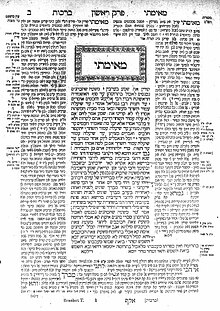
Hermann Ebbinghaus was a German psychologist who pioneered the experimental study of memory, and is known for his discovery of the forgetting curve and the spacing effect. He was also the first person to describe the learning curve. He was the father of the neo-Kantian philosopher Julius Ebbinghaus.

The Talmud is the central text of Rabbinic Judaism and the primary source of Jewish religious law (halakha) and Jewish theology. Until the advent of modernity, in nearly all Jewish communities, the Talmud was the centerpiece of Jewish cultural life and was foundational to "all Jewish thought and aspirations", serving also as "the guide for the daily life" of Jews.

A mnemonicdevice, or memory device, is any learning technique that aids information retention or retrieval (remembering) in the human memory for better understanding.

The Mishneh Torah, also known as Sefer Yad ha-Hazaka, is a code of Rabbinic Jewish religious law (halakha) authored by Maimonides. The Mishneh Torah was compiled between 1170 and 1180 CE, while Maimonides was living in Egypt, and is regarded as Maimonides' magnum opus. Accordingly, later sources simply refer to the work as "Maimon", "Maimonides", or "RaMBaM", although Maimonides composed other works.

Memorization is the process of committing something to memory. It is a mental process undertaken in order to store in memory for later recall visual, auditory, or tactical information.

The Tosafot,Tosafos or Tosfot are medieval commentaries on the Talmud. They take the form of critical and explanatory glosses, printed, in almost all Talmud editions, on the outer margin and opposite Rashi's notes.
Piphilology comprises the creation and use of mnemonic techniques to remember many digits of the mathematical constant π. The word is a play on the word "pi" itself and of the linguistic field of philology.

Masei, Mas'ei, or Masse is the 43rd weekly Torah portion in the annual Jewish cycle of Torah reading and the 10th and last in the Book of Numbers. The parashah comprises Numbers 33:1–36:13. The parashah discusses the stations of the Israelites' journeys, instructions for taking the land of Israel, cities for the Levites and refuge, and the daughters of Zelophehad.

The Seven Sins of Memory: How the Mind Forgets and Remembers is a book by Daniel Schacter, former chair of Harvard University's Psychology Department and a leading memory researcher.
Pilpul is a method of studying the Talmud through intense textual analysis in attempts to either explain conceptual differences between various halakhic rulings or to reconcile any apparent contradictions presented from various readings of different texts. The word pilpul has entered English as a colloquialism used by some to indicate extreme disputation or casuistic hairsplitting.
The title mnemonist refers to an individual with the ability to remember and recall unusually long lists of data, such as unfamiliar names, lists of numbers, entries in books, etc. Some mnemonists also memorize texts such as long poems, speeches, or even entire books, of fiction or non-fiction. The term is derived from the term mnemonic, which refers to a strategy to support remembering, but not all mnemonists report using mnemonics. Mnemonists may have superior innate ability to recall or remember, in addition to relying on techniques.
The art of memory is any of a number of loosely associated mnemonic principles and techniques used to organize memory impressions, improve recall, and assist in the combination and 'invention' of ideas. An alternative term is "Ars Memorativa" which is also translated as "art of memory" although its more literal meaning is "Memorative Art". It is also referred to as mnemotechnics. It is an 'art' in the Aristotelian sense, which is to say a method or set of prescriptions that adds order and discipline to the pragmatic, natural activities of human beings. It has existed as a recognized group of principles and techniques since at least as early as the middle of the first millennium BCE, and was usually associated with training in rhetoric or logic, but variants of the art were employed in other contexts, particularly the religious and the magical.

Joshua Foer is a freelance journalist and author living in Brookline, Massachusetts, with a primary focus on science. He was the 2006 USA Memory Champion, which was described in his 2011 book, Moonwalking with Einstein: The Art and Science of Remembering Everything. He spoke at the TED conference in February 2012.
The Rise of David Levinsky is a novel by Abraham Cahan. It was published in 1917, and remains Cahan's best known work.
Illui is a young Talmudic prodigy. The Hebrew term is applied to exceptional Talmudic scholars among Orthodox Jews.
Exceptional memory is the ability to have accurate and detailed recall in a variety of ways, including hyperthymesia, eidetic memory, synesthesia, and emotional memory. Exceptional memory is also prevalent in those with savant syndrome and mnemonists.
In psychology, the misattribution of memory or source misattribution is the misidentification of the origin of a memory by the person making the memory recall. Misattribution is likely to occur when individuals are unable to monitor and control the influence of their attitudes, toward their judgments, at the time of retrieval. Misattribution is divided into three components: cryptomnesia, false memories, and source confusion. It was originally noted as one of Daniel Schacter's seven sins of memory.

Hadran is a short prayer recited upon the completion of study of a tractate of the Talmud or a Seder of Mishnah. It is also the name of the scholarly discourse delivered at a siyum masechet, the ceremony celebrating the completion of study of a Talmudic tractate.
Elaborative encoding is a mnemonic that relates to-be-remembered information to previously existing memories and knowledge.










